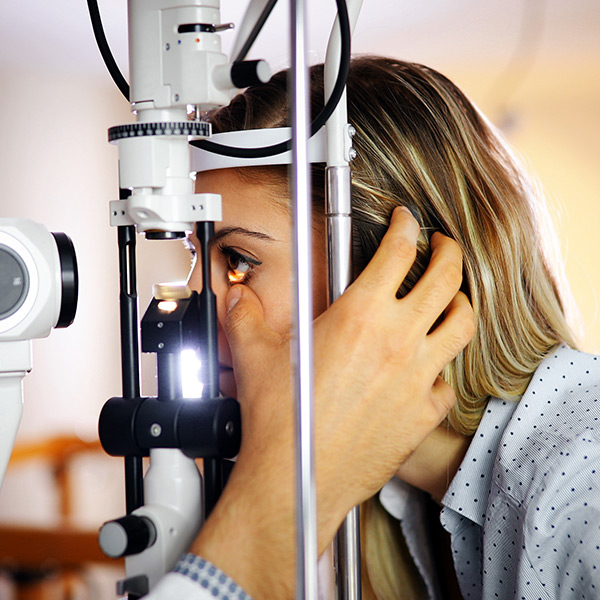Medical Marijuana for Glaucoma
If you or a loved one is struggling with Glaucoma, you should know that medical marijuana may be available for treating symptoms of this condition. Schedule an appointment with us at 888-316-9085 to start your evaluation process!

Glaucoma is a condition that causes optic nerve damage in the eye.
The cause behind this illness is the buildup of fluid in front of the eye. When fluid accumulates, the increased pressure causes significant harm to the optic nerves. Continual damage can eventually lead to partial vision loss or permanent blindness.
According to the Glaucoma Research Foundation, approximately 3 million Americans have an eye condition. In addition, almost half of them are even unaware of their ailment. Glaucoma is gradually becoming one of the leading causes behind blindness in the United States, and 10% of people are experiencing vision loss with this disease, despite receiving adequate treatment.
Patients living with Glaucoma are eligible for treatment with medical marijuana in Pennsylvania. Compassionate Certification Centers is here to help!
How Do You Diagnose Glaucoma?
In the initial stages, glaucoma causes side vision loss, also known as peripheral vision loss, which is generally undetectable. A regular eye checkup is essential to screen glaucoma and other issues related to the vision. Once you have been diagnosed with an eye issue, it is recommended that you also undergo an optic nerve check with an ophthalmoscope, eye pressure check, and visual field assessment (if required).
What are the Causes of Glaucoma?
One of the primary reasons behind this disease is damaging the optic nerve. With a gradual deterioration in the optic nerve, blind spots start developing in the visual field. Nerve damage is closely related to increased eye pressure. Ultimately, when there is hypertension, pressure becomes higher than normal, and leads to glaucoma. Other than this, symptoms like blocked blood vessels in the eye, eye injury, inflammatory conditions, and severe eye infection can also lead to glaucoma.
Statistics to Consider
- More than 7 million American, 40 years or older age, are dealing with the most common type of this disease, known as open-angle glaucoma
- The United States economy ends up losing $2.86 billion each year due to glaucoma
- Several new studies are being conducted to discover treatment focused on decreasing the eye pressure and preserving the optic nerve
Qualifying Conditions of Glaucoma
- Absolute glaucoma
- Acute Angle Closure Glaucoma
- Anatomical Narrow Angle Glaucoma
- Capsular Glaucoma with Pseudoexfoliation of Lens
- Chronic Angle Closure Glaucoma
- Congenital Glaucoma
- Exfoliation Syndrome
- Glaucoma Angle Closure
- Glaucoma Drainage Implants
- Glaucoma Neovascular
- Glaucoma Secondary to Drugs
- Glaucoma Secondary to Eye Inflammation
- Glaucoma Secondary to Other Eye Disorders
- Glaucoma Secondary to Eye Trauma
- Hypersecretion Glaucoma
- Low Tension Glaucoma
- Ocular Hypertension
- Open Angle Glaucoma
- Pigmentary Glaucoma
- Preglaucoma
- Primary Angle Closure Glaucoma
- Primary Angle Closure Without Glaucoma Damage
- Residual Stage of Open Angle Glaucoma
- Steroid Responder
- Traumatic Glaucoma Due to Birth Injury
- Weill Marchesani Syndrome
- Unspecified Glaucoma
Commons Symptoms of Glaucoma
Considering that glaucoma has a variety of types and forms, symptoms may differ according to the age of the patient and the severity of the condition. Here are some of the common symptoms associated with glaucoma:
- Peripheral vision loss, generally in both eyes
- Severe eye pain
- Sudden visual disturbances
- Blurred vision
- Redness in the eye
If you experience any of the signs referenced above, then you should schedule an appointment with an eye specialist and get it checked. Upon diagnosis of the condition, you can then consider medical marijuana and/or CBD as a valid treatment option.
Benefits of Medical Marijuana for Glaucoma Patients
Below are a few of the positive effects that people received when using medical marijuana to manage glaucoma:
- Anti-inflammatory relief
- Analgesic and anti-nausea relief
- Reduced intraocular pressure in the eye
How to Get a Medical Marijuana Card for Glaucoma
Due to the seriousness of the disease, many states have legalized the use of medical marijuana for Glaucoma. Below is a step-by-step guide on how to get your medical marijuana card:
- Register over the phone or online
- Talk to a medical marijuana doctor
- Get your medical marijuana card
Compassionate Certification Centers is here to provide you with the support, care, and guidance you need to get certified for a medical marijuana card. Schedule an appointment with us at 888-316-9085 to start your evaluation process!



